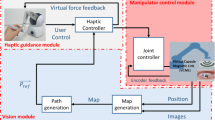Abstract
Cardiovascular disease is one of the leading causes of death in the United States and also a major disease nationwide. Over 700,000 coronary artery bypass graft (CABG) procedures are performed annually all around the world, of which 350,000 are performed in the United States. The use of mechanical stabilizers to isolate and immobilize the surface region of the heart is not without its limitations such as hemodynamic deterioration, and arrythmia induction requiring inotropic support. Consequently, the use of mechanical stabilizers leads to a poor immobilization of the surgical field in spite of significant forces of traction and retraction used with these devices. The primary goal of this research is to develop effective haptic (sense of touch) and visual servoing methods with the long-term goal of eliminating the need for mechanical stabilizers and extracorporeal support for CABG procedures. We present in this paper the results from our initial work in the area of tracking a deformable membrane using vision and providing haptic feedback to the user, based on the visual information through the vision hardware and the material properties of the membrane. In our first experiment, we track the deformation of a rubber membrane in real-time through stereovision while providing haptic feedback to the user interacting with the reconstructed membrane through the PHANToM haptic device. In the second experiment, we verify the ability of our vision system to track a point on a surface undergoing a complex 3D motion.
Similar content being viewed by others
REFERENCES
Astley OR and Hayward V. Multirate haptic simulation achieved by coupling finite element meshes through norton equivalents. In Proceedings of the 1998 IEEE International Conference on Robotics and Automation, Leuven, Belgium, May 1998, pp 989–994.
Astley OR and Hayward V. Design constraints for haptic surgery simulation. In Proceedings of the 2000 IEEE International Conference on Robotics and Automation, San Francisco, California, 24–28 April 2000, pp 2446–2451.
Bielser D and Gross MH. Interactive simulation of surgical cuts. In Proceedings of the Eigth Pacific Conference on Computer Graphics and Applications, Hong Kong, China, 3–5 Oct. 2000, pp 116–125.
Burdea GC. Haptic feedback for virtual reality. Int J Des Innovation Res 2: 17–29, 2000.
Cavusoglu MC and Tendick F. Multirate simulation for high fidelity haptic interaction with deformable objects in virtual environments. In Proceedings of IEEE International Conference on Robotics and Automation, San Francisco, CA, 24–28 April 2000, pp 2458–2465.
Cohen RG, Mack MJ, Mack MF, Fonger JD, and Landrèneau RJ. Minimally Invasive Cardiac Surgery, Quality Medical Publishing Inc., 1999, St. Louis, MO.
Delingette H. Toward realistic soft-tissue modeling in medical simulation. Proc IEEE 86: 512–523, 1998.
Delingette H, Cotin S, et al. Real-time elastic deformations of soft tissues for surgery simulation. IEEE Trans Visual Comput Graphics 5: 62–73, 1999.
Elefteriades JA. Mini-CABG: A step forward or backward? The pro point of view. J Cardiothorac Vasc Anesth 11: 661–668, 1997.
Frank AO, Twombly A, et al. Finite element methods for real-time haptic feedback of soft-tissue models in virtual reality simulators. In Proceedings of the IEEE Conference onVirtual Reality,Yokohama, Japan, 13–17 March 2001, pp 257–263.
James DL and Pai DK. ARTDEFO, Accurate real time deformable objects. In ACM SIGGRAPH Conference Proceedings, Los Angeles, California, 8–13 Aug. 1999, pp 65–72.
Keeve ES, Girod S, et al. Anatomy-based facial tissue modeling using the finite element method. In Proceedings of the IEEE Conference on Visualization, San Francisco, California, 27 Oct 1996, pp 21–28.
Mendoza CA and Laugier C. Realistic haptic rendering for highly deformable virtual objects. In Proceedings of the IEEE Conference on Virtual Reality, Yokohama, Japan, 13–17 March 2001, pp 264–269.
Nedel LP and Thalmann D. Real-time muscle deformations using massspring systems. In Computer Graphics International, Hannover, Germany, 22–26 June 1998, pp 156–165.
Pai DK, Lang J, et al. Acme, a telerobotic active measurment facility. In Proceedings of the Sixth International Symposium on Experimental Robotics, Sydney, New South Wales, Austrailia, 26–28 March 1999.
Papadimitriou DV and Dennis TJ. Epipolar line estimation and rectification for stereo image pairs. IEEE Trans Image Process, 1996.
Trucco E and Verri A. Introductory Techniques for 3-D Computer Vision. Englewood Cliffs, NJ: Prentice Hall, 1998.
Vedula S, Baker S, et al. Three-dimensional scene flow. In International Conference on Computer Vision, Kérkyra, Greece, 20–21 September 1999, pp 722–729.
Young WC and Budynas RG. Roark's Formulas for Stress and Strain. New York: McGraw Hill, 2001.
Zhang Y and Kambhamettu C. Integrated 3D scene flow and structure recovery from multiview image sequences. In IEEE Comp. Soc. Conference on Computer Vision and Pattern Recognition, Hilton Head Island, South California, 13–15 June 2000, pp 674–681.
Zhuang Y and Canny J. Haptic interaction with global deformations. In Proceedings of the IEEE International Conference on Robotics and Automation, San Francisco, California, 24–28 April 2000, pp 2428–2433.
Author information
Authors and Affiliations
Rights and permissions
About this article
Cite this article
Kennedy, C.W., Hu, T., Desai, J.P. et al. A Novel Approach to Robotic Cardiac Surgery Using Haptics and Vision. Cardiovascular Engineering 2, 15–22 (2002). https://doi.org/10.1023/A:1019926620096
Issue Date:
DOI: https://doi.org/10.1023/A:1019926620096




